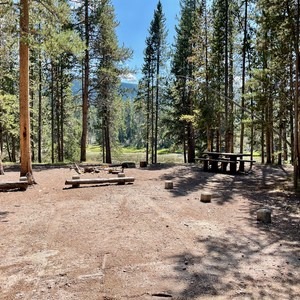You are here
Bannack State Park is Montana’s First Territorial Capital and its most preserved ghost town. Catch a glimpse of Montana’s early frontier life, now heavily steeped in an eerie, ghostly silence.
Sixty buildings and fixtures still stand, including the old courthouse and converted hotel, the assay office, saloon, schoolhouse and Masonic Lodge, Methodist Church, jail cells and gallows. Many of the buildings contain an undeniable feeling of being abandoned (at times haunted) with their old, squeaky floorboards and peeling wallpaper.
Miners first came to this area in 1862. John White and the “Pikes Peakers” discovered gold in Grasshopper Creek. News of gold spread quickly, bringing miners with dreams of riches in droves. By the end of 1862, almost $500,000 in gold was removed. In its golden years, Bannack was several thousand strong. Many miners found their evening entertainment from the Hurdy Gurdy girls, popular entertainers who also sought their own financial gains. Over the years, more “respectable women,” families and tradesmen moved to town. But as booms always do, the gold busted and the population shrank rapidly. Bannack was at last abandoned by the early 1950s.
The town was not a stranger to lawlessness. Confrontations between road agents and vigilantes were common. Road agents were notorious men who charged, murdered and robbed unfortunate individuals and miners. The most notorious of the Bannack road agents was Henry Plummer, a convict who established a gang in November 1862 called the “Innocents” and supposedly committed numerous robberies and murders. The road agents were soon held in check by a vigilante committee. The vigilantes pursued gang members, and in just over a month they had banished or executed most of them at the gallows. Thomas Dimsdale, a vigilante, spoke of the road agents: “It is probable that there never was a mining town of the same size that contained more desperadoes and lawless characters than did Bannack during the winter of 1862-1863.”
Bannack comes back to life during Bannack Days, a celebration always held the third weekend of July, and Bannack Ghost Walks, held at the end of October. During Bannack Days, music fills the streets, along with an occasional gunfight in the much-loved historical reenactment. Other activities include wagon rides, gold panning and candle making. Bannack Ghost Walks also feature historical reenactments, but in the dark of the night. Shows are capped at 100 people and require reservations and a flashlight.
Bannack has two campgrounds for visitors and a large group day area. Vigilante Campground has 16 campsites and one tipi site for up to six people. Just down the gravel road lies the Road Agent Campground, which has eight sites with ample shade. Only Vigilante Campground has potable water. Both campgrounds have one vault toilet each. All campsites at the park are nonelectric and can be reserved online through Montana State Parks.
Logistics + Planning
Current Weather: Powered by Dark Sky




























Comments
Sign In and share them.